Tuesday, 31 May 2011
Sunday, 22 May 2011
_Progress
Here is a few tests/unfinished outcomes:
Below is video outcome of vertical left and horizontal top going lines that I followed. It proves to be interesting, although I am tempted to stop here and not over do it by layering again. This video means half of my whole lines, so if I wanted to finish whole building outline it would be double layers of what I have here.
Colour tones still needs to be adjusted. Tried to edit the colours layer by layer but it turned out to be that some of the details gone lost, so will need to edit the colouring right after I have a final outcome, going still by still.
Here is how it looks with only one layer- lines going horizontal.
That's how it turned out to be with colours blacked out- some of the intesting details in film lost it's beautiful quality.
Still needs to be done:
Colour edit.
Sort out frame size format as I can't figure out why video still stays in a black frame after trying many many options.
Friday, 20 May 2011
_Soundtrack
Another possibilities was:
Ellen Allien- Bim
Autechre- Dropp
Autechre- Foil
Autechre- Windwind
Autechre- Dael/Creeping
It suited the theme I was going for, this futuristing cyber creepy feel, but felt that something was still missing. And probably it was rhythm that was missing.
Thursday, 19 May 2011
_Questions
4 film-layers (left/right vertical, top/bottom horizontal).
Will it not be visual chaos layering them together?
But having 2 layers only will not complete the whole building outline?
Wednesday, 18 May 2011
_Plans
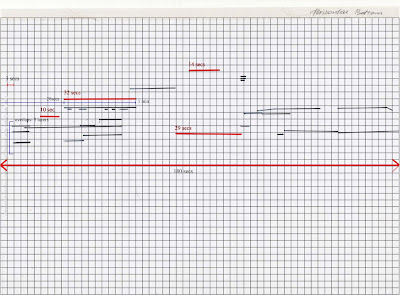
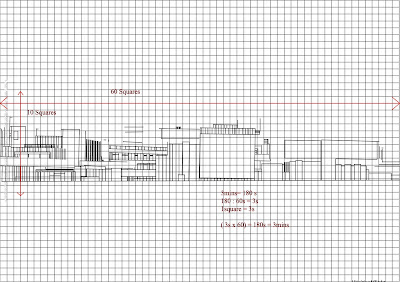
Here I started to code film - transfer film into lines or vice versa- transfer lines into film.
Previously I outlined existing landscape to create a new space within by extracting contours of the buildings and separating/distorting them- placing into perspective to have sense of depth of field to it.
Now what I want to do- to translate this space into film which involves timing. What would happen if I would take an outline of the buildings to be my outline for video timing- length of the lines directinging the timing of each video.
I took videos with horizontal and vertical motion, that will be used depending on what lines I will need to define.
So now I figured out that whole length has 60 squares. I want to make a 3mins film, it means that each square is 3s long. Depending on that, I will do video of each of the lines layer (horizontal left/right; vertical left/right) .
Some of the lines going along together at the same time- that would mean that it overlays in my timeline and will be as multiplied layers (depending on how many lines).
Later on I thought of joining all films together into one- this way I would have all layers of lines transfered into film layers and by multiplying them I would create a same space that was in reality (because I followed the same outline) but a new filmic experience.
Tuesday, 17 May 2011
Monday, 16 May 2011
_Soundtrack- Ellen Allien- Bim
Thought of music that would go with video. In mind I had something minimal/experimental/monotonic sound, although computer made rather than naturally created. Whole film+lines+monochrome made me think of scanner sounds, something along those lines. At the moment this is what I was looking for, unless I will find something even better.
Still whole filming of the model to do, but having soundtrack is a good base to have I think, so in that way I already have a rhythm path to follow when editing.
Friday, 13 May 2011
_For inspiration/ Urban spectrum
Work by Taras Gesh. Great use of mirrors and breaks up to achieve distorted city view which already creates a new spaces and well as it is own rhytmic and visual pattern.
_Remove reflections
Did some research on how to remove or manually reduce the reflection absorbed in photograph or video. Here is all of the most useful advises from forums. Now is just the matter of testing them.
You'd probably want a polarizing filter, unless it's truly a mirrored sunglass, like mine are. Than you need to put black, gray, or graduated material in front of the lenses (out of the shot) to control the reflection you want.
No they're reflecting the things infront of them that the camera cant see... They're plastic. And i dont have a polarizing filter =S Thanks anyway.
Maybe somebody in the Lighting section can better answer your question. Reflections from Glass and metal is one of the toughest things to solve when it comes to still life photography. Some people use tents that surround the object on all sides including the front. Then they place a hole in the front of the Tent where they can insert the lens. Unfortunately, then the lens reflects off the object. You can remove this reflection using Photoshop, or you can pull your hair out trying to figure out what camera/light angle to use to avoid reflections. Good luck !
a CPL should do the trick.
It's trickier with sunglasses because the surface is curved--still, use a gooseneck lamp or some such as a light source and place it so the light comes in a a 45 degree angle in relation to the subject-camera axis. Do this in a dark room or at night. Play with the light source location to eliminate as many reflections as you can when you look through the viewfinder. Use Photoshop to minimize any remaining reflections.
Rig your own light tent with a sheet or use a translucent plastic laundry or storage box or ....
Black does not reflect, so use black scrim to cover unwanted items that are reflecting. You may also find it useful to do some reverse ray tracing using a screen pointer where the camera lens will be: aim it at various points on the subject and observe where they reflect to. Then make sure they're black. You may find it necessary to use some polarising film on your lights as well as a polariser on your lens. Cross polarisation is a useful technique for suppressing unwanted reflections - used when photographing oil paintings for example. Lighting at 45 degrees can also help reduce reflections into the lens.
I use a piece of 4ft x 4ft black foamcore with a hole in the middle of it for the camera lens when shooting this kind of photograph. You can buy white or black foamcore at most art supply stores. These technique leaves only a small catch light containing the camera lens, which can more easily be removed in Photoshop.
Monday, 9 May 2011
_Cognition
- The mental process of knowing, including aspects such as awareness, perception, reasoning, and judgment.
- That which comes to be known, as through perception, reasoning, or intuition; knowledge.
Saturday, 7 May 2011
_Beau Lotto: Optical illusions show how we see
Main observation from this talk learned-
-There is no direct access to physical world other then our senses. The way object is indroduced, depending on quality of light, materiality etc. that's what's been sent to our brain as a picture of reality.
-Brain is a mechanism helping to associate with something- by manipulating the way we associate, illusion is introduced.
Friday, 6 May 2011
_Lines squared
Thursday, 5 May 2011
Wednesday, 4 May 2011
_Contours
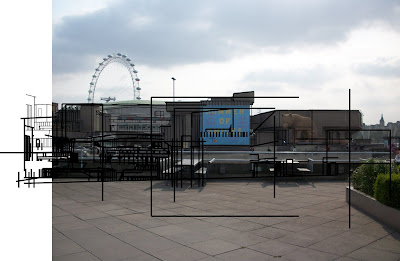
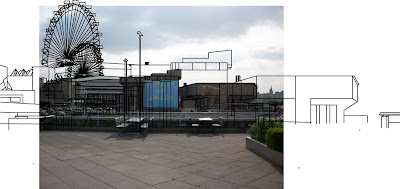
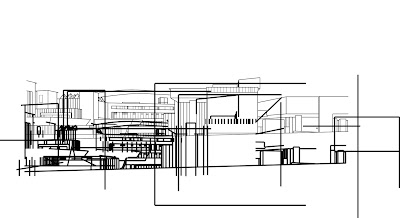
Playing around with outlines gave me clearer idea od what I would like to do next.
Contouring, distorting the landscape, splitting parts of the buildings apart and putting it back together.
Insertion of new structure into a landscape will give a different perspective/perception of what we see. An illusion and reality.
_Gordon Matta Clark
Monday, 2 May 2011
_Model 1




 Model of parts of the lanscape being distant to each other. This gave me an idea of how arrangement would work in the space, not only that it would be an illusion(although for illusion distance measurements is very important) but also a new space in between of the each part. It made a statement that by creating something new, even by making an illusion or so, there is a new route, a new track for peoples flow.
Model of parts of the lanscape being distant to each other. This gave me an idea of how arrangement would work in the space, not only that it would be an illusion(although for illusion distance measurements is very important) but also a new space in between of the each part. It made a statement that by creating something new, even by making an illusion or so, there is a new route, a new track for peoples flow.
_Detached landscape view
First attempt to detach parts of the view and put them back again. Was very interesting to see the outline and it's shadows on the individual pieces.
_George Michael Brower
Work by George Michael Brower.
This is a great example of an idea i'm carrying in my mind. Extracting parts of the landscape and placing them back again.
Wednesday, 27 April 2011
_Anna.eins
Another great example of the way to deconstruct perception of what you normaly see. Abstract structure hang from the ceiling blocks light rays and creates a shadow. I think this is a good example of how you can play around positive and negative spaces. Where this time the actual object is deformed and acts as a negative space, instead of being positive, creating shadows where final outcome can be seen at.
_Esther Stocker
Wednesday, 20 April 2011
The apparent place
The apparent place of an object is the position in space as seen by the observer. Because of physical and/or geometrical effects it has a deviation from the "true position".
Parallax
Parallax is the difference in the angular position of two stationary points relative to each other from different viewing positions. Nearby objects have a larger parallax than more distant objects when observed from different positions, so parallax can be used to determine distances.
As the viewpoint moves side to side, the objects in the distance appear to move more slowly than the objects close to the camera.As the eyes of humans and other animals are in different positions on the head, they present different views simultaneously. This is the basis of stereopsis , the process by which the brain exploits the parallax due to the different views from the eye to gain depth perception and estimate distances to objects.
In a philosophic/geometric sense: An apparent change in the direction of an object, caused by a change in observational position that provides a new line of sight. The apparent displacement, or difference of position, of an object, as seen from two different stations, or points of view.
Perspectives
Linear perspective
T
 he human eye judges distance by the way elements within a scene diminish in size, and the angle at which lines and planes converge. This is called linear perspective. The distance between camera and subject and the lens focal length are critical factors affecting linear perspective. This perspective changes as the camera position or viewpoint changes. From a given position, changing only the lens focal length, and not the camera position, does not change the actual viewpoint, but may change the apparent viewpoint.
he human eye judges distance by the way elements within a scene diminish in size, and the angle at which lines and planes converge. This is called linear perspective. The distance between camera and subject and the lens focal length are critical factors affecting linear perspective. This perspective changes as the camera position or viewpoint changes. From a given position, changing only the lens focal length, and not the camera position, does not change the actual viewpoint, but may change the apparent viewpoint. The use of different focal-length lenses in combination with different lens-to-subject distances helps you alter linear perspective in your pictures. When the focal length of the lens is changed but the lens-to-subject distance remains unchanged, there is a change in the image size of the objects, but no change in perspective. On the other hand, when the lens-to-subject distance and lens focal length are both changed, the relationship between objects is altered and perspective is changed. By using the right combination of camera-to-subject distance and lens focal length, a photographer can create a picture that looks deep or shallow. This feeling of depth or shallowness is only an illusion, but it is an important compositional factor.
Using a short-focal-length lens from a close camera-to-subject distance, or viewpoint, produces a picture with greater depth (not to be confused with depth of field) than would be produced with a standard lens. Conversely, using a long-focal-length lens from a more distant viewpoint produces a picture with less apparent depth.
Rectilinear perspective Most lenses produce rectilinear perspective that are typical of what the human eye sees. This is to say that lines that are straight in the subject are reproduced straight in the picture. Most pictures are made with rectilinear lenses.
Most lenses produce rectilinear perspective that are typical of what the human eye sees. This is to say that lines that are straight in the subject are reproduced straight in the picture. Most pictures are made with rectilinear lenses.
Fisheye lenses and the lenses used on panoramic cameras produce a false perspective. A panoramic lens produces panoramic or cylindrical perspective. In other words, all straight horizontal lines at the lens axis level are recorded as straight lines, and all other straight horizontal lines either above or below the lens axis level are reproduced as curved lines. The other false perspective is produced by a fisheye lens in which all straight lines in the subject are imaged as curved lines toward the edges of the picture.
Vanishing point perspective
 In vision, lines that are parallel to each other give the sensation of meeting at vanishing points. When parallel lines, either horizontal or vertical, are perpendicular to the lens axis, the vanishing points are assumed to be at infinity. Other lines, those which are parallel to the lens axis, and all other parallel lines at all other angles to the lens axis meet at definable vanishing points. Thus lines that are parallel to the lens axis, or nearly parallel, start in the front of the picture and meet at vanishing points within the picture or at finite points outside the picture.
In vision, lines that are parallel to each other give the sensation of meeting at vanishing points. When parallel lines, either horizontal or vertical, are perpendicular to the lens axis, the vanishing points are assumed to be at infinity. Other lines, those which are parallel to the lens axis, and all other parallel lines at all other angles to the lens axis meet at definable vanishing points. Thus lines that are parallel to the lens axis, or nearly parallel, start in the front of the picture and meet at vanishing points within the picture or at finite points outside the picture.
Height perspective
The place where the base of an object is located on the ground in a picture is a clue to its distance from the camera viewpoint; for example, in a landscape scene, the ground or ground plane rises toward the horizon. The higher up in the ground area of the picture (up to the horizon) that the base of an object is located, the further away it seems from the viewpoint and the greater its height perspective.
Overlap perspective
Monday, 18 April 2011
_Video compilation
Very draft compilation of my videos taken for a group book project. Wanted to play around with videos I have filmed for group project, although still a lot to do for it to be finished.
Sunday, 3 April 2011
_Thoughts
_What could be my starting point for a further inverstigations towards the my own concept proposal.
_Should I carry on investigating Southbank, or better be more concentrated on what object/proposal will look like and better be concentrated on development of it.
_More experiments + what programe towards the space I want to involve?
Untitled-1

I went to the Southbank to explore the existing buildings that naturally shapes different forms/distorts the perception of knowing what you will see next. Southbank is the place surrounded by brutal architecture, many very cube like buildings and shapes- almost surreal space if you like. After analysing previous research, I started to think how shapes of architecture is changing depending on time in the real living environment? As a starting point I took one of the Elizabeth Hall buildings. Went from right to left side and took photograph every sixth of my step.
An interesting realisation found of how your perception of building changes by changing the viewing perspective.
Saturday, 2 April 2011

As a starting point I started analysing an existing object which deconstructs itself and gets back to places depending on your move. Here is the overlay of structure gradualy destorting it's shape.
It gives you a clear understanding of how it works-structure is trimmed into pieces and laid the way it makes space inbetween- or one point perspective and structure depending on it.

Tuesday, 22 March 2011
_How can I turn illusion into a 3D space.
_Working on Elizabeth House- how I could come across the message of forgotten existance of the building and how could I bring it back to life.
_Deconstructing building into parts- creating meaning of time by bringing parts back together
_through illusion distorting peoples senses to sensation by introducing to something new-
_by time and motion getting parts of object back together to make a whole-
_people have a new perception of a building.




































